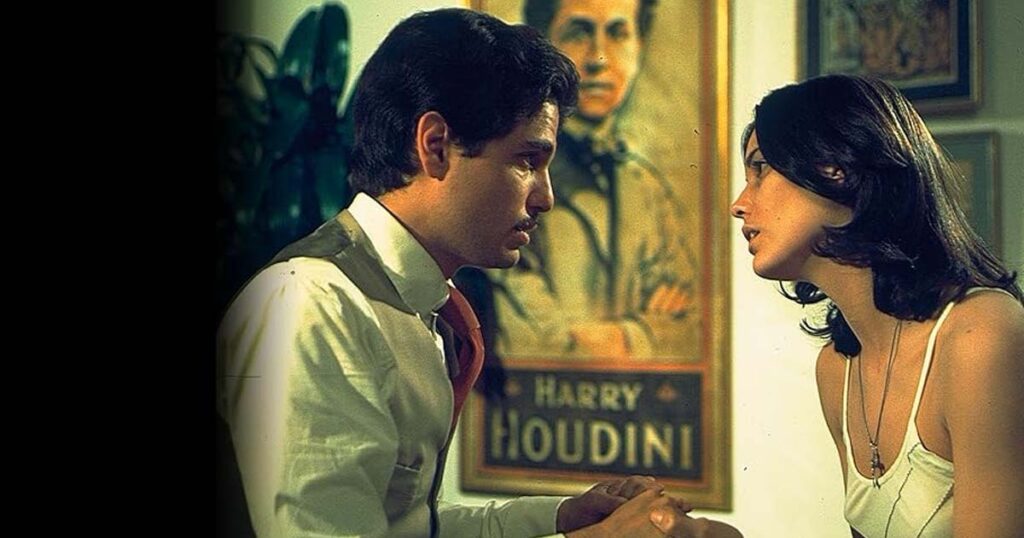The era of the 1970s simmered with an unshakable dread when it felt that hell wasn’t just a distant, abstract threat but more of a looming inevitability. With Rosemary’s Baby, The Exorcist, and The Omen, the cultural climate didn’t just breed fear. It inspired it, setting the stage for a relentless wave of films, books, and TV specials obsessed with the eternal clash between divine forces and infernal ones.
The Sentinel: A Different Kind Of Religious Horror
Amidst this wave of hellish storytelling, Michael Winner’s The Sentinel carved out its own uniquely disturbing place. The movie wasn’t a simple battle of light triumphing over darkness, nor a comforting tale of faith overcoming evil. Instead, it plunged into the murky waters of corruption and sinister forces lurking in holy places.
With the unnerving disquiet of a ghost story and the dreadful weight of religious horror, the film delivered an unsettling tale wrapped in the grotesque and the profane.
The only thing standing between the world and Hell is you. The Sentinel (1977) was shocking for its time for casting people with severe medical deformities in addition to using practical effects. Absolutely chilling! pic.twitter.com/kvBjpwKlbw
— R. J. Crowther Jr. (@RJCrowtherJr) September 10, 2024
A Fashion Model’s Dream Apartment… Or A Nightmare?
The film centers around Alison Parker, a fashion model played by Cristina Raines, who is seeking a fresh start in a Brooklyn brownstone owned by a church. The building appears vacant, save for one solitary resident, a blind priest stationed at the very top floor, endlessly watching.
Soon enough, her solitude is disrupted, and a carousel of odd, intrusive neighbors introduces themselves, none more memorable than the unsettling yet strangely pleasant Mr. Chazen (Burgess Meredith). However, Alison’s new home isn’t just peculiar; it’s insidious, and as her health declines and reality distorts, her boyfriend Michael (Chris Sarandon) begins investigating, uncovering the building’s horrific secrets.
Though The Sentinel never reached the same heights as its more famous predecessors, it assembled an impressive cast, with appearances by Ava Gardner, Christopher Walken, and Jeff Goldblum. It is a hidden gem in the horror genre, which may have been overlooked, but it got under the skin of those who dared to watch.
A House Of Horror Rooted In Faith
The film masterfully blends classic haunted house tension with the weight of religious dread. From its opening moments in an Italian church, where a solemn monsignor utters a cryptic warning, the audience is primed for something unholy.
Alison’s apartment itself is a trap—just too pristine and perfect, waiting to reveal its horrors. And those neighbors aren’t just peculiar; they’re destabilizing and experts at chipping away at her confidence.
The ghosts lurking within the building aren’t just lost souls; they have a purpose, and their connection to the film’s central mystery makes them even more unnerving. The deeper Alison falls, the more the film leans into its religious overtones, culminating in a horrifying revelation.
When the Church Becomes the Monster
Unlike traditional horror films that pit priests against demons in an age-old battle for souls, The Sentinel flips the script. Here, the Church isn’t a savior but an oppressor. The film’s villains aren’t just the ghouls haunting Alison’s apartment but the institution claiming to be protecting humanity.
Alison’s tragic past, marred by an abusive father, a crisis of faith, and an attempted suicide, makes her the ideal target. But, instead of offering salvation, the Church manipulates her suffering for its own ends. Unlike many horror heroines who fight for survival, Alison is given no real choice. She is used, shaped, and sacrificed in a war without true victors.
If The Sentinel wasn’t unsettling enough, its visual and thematic choices push it into even darker territory. Alison’s torment is underscored by psychosexual nightmares, brutal supernatural assaults, and an increasing sense of degradation.
But its most controversial moment comes in the climax, with Winner’s decision to cast real-life actors with facial and bodily deformities as demons. This choice, meant to deliver raw, visceral horror, blurred the line between shock value and exploitation and solidified The Sentinel as one of the most uncomfortable films of its era, one that didn’t just scare its audience but deeply unsettled them.
For more such stories, check out Hollywood News
Must Read: Was Robert De Niro’s Legendary Taxi Driver Line Never In the Script?
Follow Us: Facebook | Instagram | Twitter | Youtube | Google News
Content shared from www.koimoi.com.

